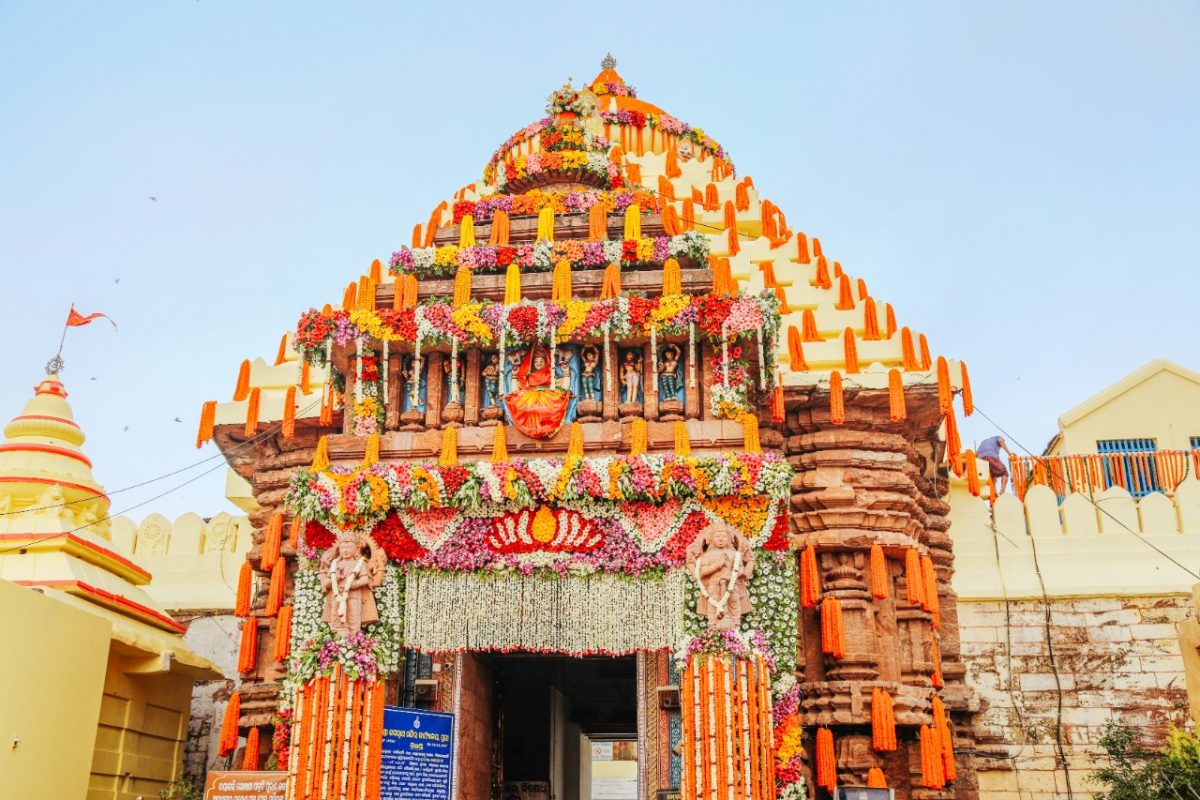Nestled in the heart of Puri, Odisha, away from the hum of the sea and the bustling Grand Road, stands a temple that holds a story as divine as the deities it welcomes. The Gundicha Temple, often referred to as the Garden House of Lord Jagannath, is not just another temple on the sacred map of India, it’s a place where mythology, devotion, and centuries-old tradition come alive, especially during the famed Rath Yatra.
If you’ve ever been curious about the spiritual vibrance of Puri beyond the towering spires of the Jagannath Temple, then let me take you on a soulful journey through the peaceful courtyards, sacred rituals, and the quiet majesty of Gundicha Temple.
A Brief Introduction to Gundicha Temple
The Gundicha Temple is intimately tied to the annual Rath Yatra, the grand chariot festival that draws millions to Puri. Located approximately 3 km from the main Jagannath Temple, this sacred site becomes the temporary home of Lord Jagannath, along with his siblings Balaram and Subhadra. While the Rath Yatra is a nine day festival, Lord Jagannatha along with his siblings stay in the Gundicha Temple for seven days.
According to legend, the temple is named after Gundicha Devi, believed to be the queen of King Indradyumna, the legendary founder of the Jagannath Temple. It is believed that she was an ardent devotee of the Lord and desired a temple to be built where He could visit her once a year. That love and longing still echo in the walls of this beautiful temple, manifesting in the annual Jagannath Rath Yatra.

The Spiritual Significance
To truly understand the significance of Gundicha Temple, one must understand the symbolism of Rath Yatra. During the festival, the deities leave their grand abode at the Jagannath Temple and are pulled on massive wooden chariots through the streets of Puri, accompanied by throngs of chanting devotees. Their destination is none other than Gundicha Temple, which becomes their retreat for seven days.
Many devotees see this journey as the Lord visiting His birthplace, or a maternal aunt’s house. There is also an underlying philosophy – God steps out of His temple to meet people, to bless those who may not be able to enter His sanctum. The Gundicha Temple thus becomes a symbol of inclusivity and divine outreach.
First Glimpse: The Arrival at Gundicha Temple
My journey to Gundicha Temple began in the early morning hours. I decided to walk along the Grand Road, the same path that Lord Jagannath takes during the Rath Yatra, from the Jagannath Temple to Gundicha Temple. The air was crisp, the sun still warming up, and there was a strange stillness, broken occasionally by the chants of early devotees.
From the outside, Gundicha Temple doesn’t scream grandeur, instead it hides behind high walls and tall coconut palms, quietly soaking in the sun. The architecture is in the traditional Kalinga style, made of light-grey sandstone, with simple carvings and lotus motifs. It lacks the bustle of its famous counterpart, which in a way, adds to its charm.
You don’t just walk into Gundicha Temple. You feel like you’ve entered a sacred garden, away from the noise, into a space where time slows down.
Inside the Temple Complex
Once inside, you’re greeted by a beautiful courtyard surrounded by trees and flowering shrubs. It truly lives up to its name the “Garden House”. The main temple sanctum is modest but powerful. There are no permanent idols inside the sanctum for most of the year. It remains empty, quiet and waiting. But during Rath Yatra, this very sanctum comes alive with the presence of Jagannath, Balaram, and Subhadra.
There is also the Narendra Pushkarini, a holy tank nearby where rituals are performed. The temple walls echo tales of rituals performed over centuries, the sweeping of the sanctum before the deities enter, the special offerings, and the loving care shown to the Lord during His week-long stay.
The priests and sevayats (temple servants) are always ready to share stories if approached respectfully. One told me how Mahalaxmi, the goddess and consort of Jagannath, once felt offended for being left behind during the Rath Yatra and how she blocked the Lord’s return, a symbolic tale of divine love and reconciliation.
When to Visit Gundicha Temple
1. Rath Yatra (June-July)
There’s no doubt—the best time to witness the glory of Gundicha Temple is during the Rath Yatra, which typically takes place in the months of June or July. For these nine days, Gundicha becomes the center of spiritual gravity. The temple hosts the deities, and a sea of devotees floods the entire stretch of the Grand Road.
If you’re visiting during this time, expect crowds but also expect magic devotion in its purest form, music, color, celebration, and a shared sense of connection among people from across the globe.
2. Off-Season Visits (October–March)
If you prefer quieter moments and a more meditative experience, visit between October and March. The weather is pleasant, the temple is peaceful, and you can sit in its gardens and reflect, undisturbed. While the deities won’t be present, the spiritual aura remains intact.
How to Reach Gundicha Temple
By Air: The nearest airport is Biju Patnaik International Airport, Bhubaneswar (about 60 km away). From there, taxis and buses are available to Puri.
By Train: Puri Railway Station is well connected to major cities like Kolkata, Delhi, and Chennai. From the station, Gundicha Temple is just a 10–15 minute auto ride away.
By Road: You can take a cab or a bus from Bhubaneswar to Puri. National Highway 316 offers a scenic and smooth journey.
Travel Tips for Visitors
- Dress Modestly: While Gundicha Temple is less crowded, it’s still a sacred space. Wear modest clothing, preferably traditional Indian attire if possible.
- Are Mobiles allowed in Gundicha Temple? Mobile cameras, belts and bags are not allowed inside the temple, so you will have to leave them outside
- Footwear: Like all Hindu temples, you’ll have to leave your shoes outside.
- Timings: The temple is usually open from 6:00 AM to 9:00 PM. However, during Rath Yatra, timings may vary.
- Photography: Photography may be restricted inside the inner sanctum. Respect the rules and the sanctity of the place.
- Local Guides: A local guide or sevayat can offer you rich stories that make your visit unforgettable.
- Parking: There is ample parking space available outside the Gundicha temple, but you might have to walk a bit to reach the temple from there.
Nearby Attractions
1. Jagannath Temple
Of course, your trip wouldn’t be complete without visiting the main Jagannath Temple, just 3 km away. It’s one of the Char Dham pilgrimage sites and an architectural marvel in its own right. Like the locals say, “Jai Jagannath’!
2. Puri Beach
After your spiritual exploration, unwind at Puri Beach. Watch the fishing boats, sip on fresh coconut water, or simply let the breeze and the roar of the waves soothe your senses.
3. Narendra Tank
A short distance away, this sacred tank is used for Chandan Yatra, another important festival involving the deities. It’s a calm place to rest and reflect.
Where to Stay
Puri has a wide range of accommodation options, from budget guesthouses to heritage hotels.
If you’re visiting during Rath Yatra, book at least 3 to 4 months in advance. The entire town gets booked out quickly.

A Spiritual Pause
As I sat under a tree in Gundicha Temple’s courtyard, a light breeze stirred the leaves. A lone priest swept the stone floor. In that quiet moment, I realized the beauty of this place is not in its ornamentation, but in its simplicity. It stands not to dazzle, but to offer sanctuary, to the Lord and to us.
While Jagannath Temple roars with life and devotion, Gundicha Temple whispers stories of rest, of longing, of divine visits, and of love that waits patiently.
Final Thoughts: Why You Should Visit Gundicha Temple
Visiting Gundicha Temple is not just about seeing another monument, it’s about experiencing a living tradition, one that has moved millions over centuries. Whether you’re a seeker, a traveler, or just someone who loves stories rooted in the soul of India, this temple offers a memory that lingers long after you’ve left.
So, next time you’re in Puri, take that short walk down the Grand Road, not just in geography, but in faith, and let the quiet grace of Gundicha Temple wrap itself around your heart. If you want any further details you can check out the following link.
May your journey be blessed, your mind be calm, and your soul find its own quiet sanctuary, just like the Lord does, once a year, in Gundicha.
My Other Posts
If you are looking for options in Kashmir, check out my posts on Pahalgam, Gulmarg, Snowfall in Kashmir, and Best Time to Visit Kashmir. If you are looking for options in Ladakh, check out Ladakh Weather, Nubra Valley, 5 Days Kashmir Itinerary, Best Packing tips for Ladakh & best tourist places in Ladakh.
If you are looking for something in Sikkim, check Tsomgo Lake, Nathu La Pass, Baba Harbhajan Singh Mandir and Batasia Loop. If you are looking for some jungle safari read Gir Safari, or Bandipur Safari, feel blessed at Sri Venugopala Swamy Temple in Mysore.
If you are looking for places to visit in the Andaman Islands, please check my posts on Radhanagar Beach & Ross Island.
If you are looking for other options, check my posts on Murud Janjira, Kashid, Pirwadi Beach and Kihim Beach in Maharashtra or Malshej Ghat, Matheran Resorts, Kailash Temple Ellora, Vandri Lake, Kelwa Beach in Palghar & Mahabaleshwar.
Alternatively, if you are interested in some Religious tourism, please check my posts on Golden Temple, Kamakhya, Trimbakeshwar, Somnath Temple, Kalighat Temple, Dakshineswar Temple and Kashi Vishwanath. If you are looking for North East Adventure tours, check my posts on Shillong, Meghalaya, Dawki, Double Decker Living Root Trek, and 7-Day North East Itinerary

